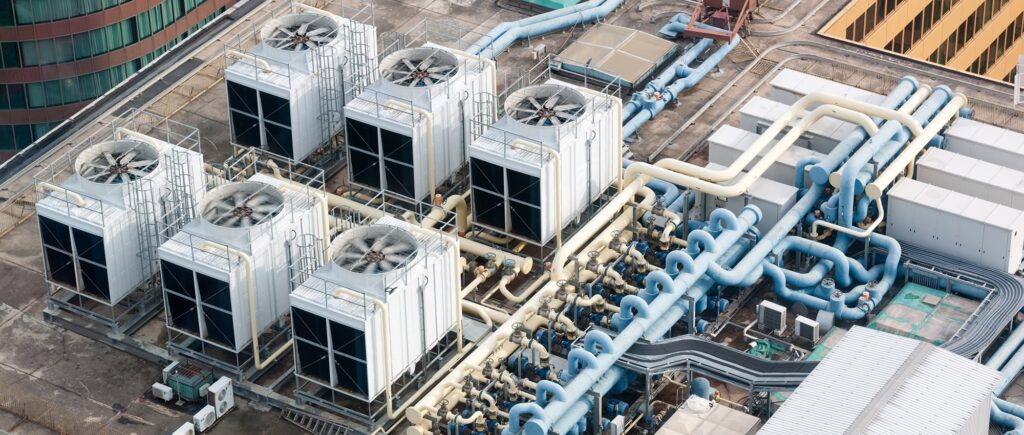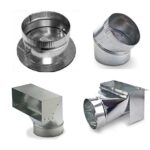Cooling towers are essential components of HVAC systems, industrial processes, and power plants, providing efficient heat dissipation and maintaining optimal operating conditions. Proper cooling tower maintenance is crucial for ensuring their efficiency, longevity, and safety. This comprehensive guide will cover everything you need to know about cooling tower maintenance, from traditional practices to the latest innovations and future trends.
The Importance of Cooling Tower Maintenance
Cooling tower maintenance is vital for several reasons:
- Efficiency: Regular maintenance ensures that the cooling tower operates at peak efficiency, reducing energy consumption and operating costs.
- Longevity: Proper care extends the lifespan of the cooling tower, delaying the need for expensive replacements.
- Safety: Maintenance prevents potential hazards, such as leaks, structural failures, and the proliferation of harmful bacteria like Legionella.
- Regulatory Compliance: Adhering to maintenance standards helps meet industry regulations and environmental guidelines.
Common Cooling Tower Issues
Understanding common issues that can affect cooling towers is the first step in effective maintenance. Some of the most frequent problems include:
1. Scaling and Fouling
Symptoms: Reduced heat transfer efficiency, increased energy consumption, and possible structural damage.
Causes: Accumulation of minerals and other deposits on heat transfer surfaces due to untreated water.
Solutions:
- Regular Cleaning: Schedule periodic cleaning to remove scale and fouling.
- Water Treatment: Use chemical or non-chemical water treatment methods to prevent scale formation.
2. Corrosion
Symptoms: Structural weakening, leaks, and reduced efficiency.
Causes: Exposure to corrosive substances in water or the environment.
Solutions:
- Protective Coatings: Apply corrosion-resistant coatings to metal surfaces.
- Water Treatment: Use corrosion inhibitors in the water treatment process.
3. Biological Growth
Symptoms: Reduced efficiency, unpleasant odors, and health risks.
Causes: Growth of algae, bacteria, and other microorganisms in the cooling water.
Solutions:
- Biocides: Regularly treat the water with biocides to control microbial growth.
- UV Treatment: Use ultraviolet light systems to disinfect the water.
4. Mechanical Failures
Symptoms: Unusual noises, vibrations, and decreased performance.
Causes: Wear and tear on components such as fans, motors, and pumps.
Solutions:
- Regular Inspections: Conduct routine inspections to identify and address wear and tear.
- Preventive Maintenance: Replace worn parts and lubricate moving components as needed.
Traditional Cooling Tower Maintenance Practices
Traditional maintenance practices have been the backbone of cooling tower upkeep for decades. These include manual inspections, mechanical repairs, and chemical treatments. Here’s an overview of some of these practices:
1. Manual Inspections
Procedure:
- Visual Inspection: Regularly inspect the cooling tower for visible signs of damage, wear, and leaks.
- Component Check: Examine all components, including fans, motors, pumps, and nozzles, for proper operation.
Benefits:
- Early Detection: Identify issues before they become major problems.
- Detailed Assessment: Thorough inspections provide a comprehensive understanding of the cooling tower’s condition.
2. Mechanical Repairs
Procedure:
- Component Replacement: Replace damaged or worn-out parts to ensure optimal performance.
- Alignment and Balancing: Ensure that fans and other rotating components are properly aligned and balanced to reduce wear.
Benefits:
- Improved Performance: Addressing mechanical issues enhances cooling tower efficiency.
- Reduced Downtime: Timely repairs prevent unexpected breakdowns and costly downtime.
3. Chemical Treatments
Procedure:
- Scale and Corrosion Inhibitors: Add chemicals to the water to prevent scale formation and corrosion.
- Biocides: Use biocides to control microbial growth.
Benefits:
- Water Quality Improvement: Chemical treatments maintain water quality, reducing the risk of scaling, corrosion, and biological growth.
- Efficiency Maintenance: Preventing these issues ensures that the cooling tower operates efficiently.
Innovations in Cooling Tower Maintenance
With advancements in technology, cooling tower maintenance has seen significant innovations. These modern techniques offer enhanced efficiency, cost savings, and environmental benefits.
1. Predictive Maintenance with IoT and AI
Technology:
- IoT Sensors: Install IoT sensors to continuously monitor parameters such as temperature, humidity, vibration, and water quality.
- AI Algorithms: Use AI algorithms to analyze data and predict potential failures.
Benefits:
- Reduced Downtime: Predict issues before they occur, allowing for proactive maintenance.
- Cost Savings: Prevent major breakdowns and extend the lifespan of the cooling tower.
- Enhanced Efficiency: Continuous monitoring ensures peak operational efficiency.
2. Advanced Water Treatment Technologies
Technology:
- Electrochemical Water Treatment: Use electrical currents to remove impurities from water.
- UV Disinfection: Employ ultraviolet light systems to kill bacteria and other microorganisms.
- Nanotechnology: Implement nanofiltration membranes to remove contaminants at the molecular level.
Benefits:
- Environmental Sustainability: Reduce chemical usage and minimize environmental impact.
- Improved Water Quality: Ensure consistent water quality and reduce scaling and corrosion.
- Reduced Maintenance: Cleaner water means fewer deposits and corrosion, leading to reduced maintenance requirements.
3. Drone Inspections
Technology:
- High-Resolution Cameras: Use drones equipped with high-resolution cameras for detailed visual inspections.
- Thermal Imaging: Employ thermal imaging capabilities to detect hot spots and potential issues.
Benefits:
- Safety: Eliminate the need for maintenance personnel to perform dangerous inspections at height.
- Efficiency: Conduct faster and more comprehensive inspections.
- Detailed Analysis: Obtain high-resolution images and thermal data for accurate diagnostics.
4. Digital Twin Technology
Technology:
- Virtual Replicas: Create digital twins of cooling towers to capture their physical and operational characteristics.
- Real-Time Data Integration: Continuously update digital twins with real-time data from IoT sensors.
Benefits:
- Predictive Maintenance: Use digital twins for detailed analysis and simulation, predicting potential issues and optimizing maintenance schedules.
- Performance Optimization: Identify the most efficient operating parameters through simulations.
- Enhanced Decision-Making: Gain valuable insights for maintenance planning and operational improvements.
5. Automated Cleaning Systems
Technology:
- Robotic Scrubbers: Use robotic systems to clean cooling towers more thoroughly and quickly than manual methods.
- High-Pressure Water Jets: Employ high-pressure water jets to remove dirt and debris.
Benefits:
- Efficiency: Clean cooling towers more thoroughly and quickly than manual methods.
- Consistency: Ensure consistent cleaning intervals and techniques.
- Labor Savings: Reduce the need for manual labor, lowering maintenance costs.
Future Trends in Cooling Tower Maintenance
Several emerging trends promise to further revolutionize cooling tower maintenance. Staying ahead of these trends can help businesses maximize the benefits of their cooling systems.
1. Integration of Renewable Energy Sources
Trend:
- Solar Panels: Use solar panels to power cooling towers.
- Wind Turbines: Employ wind turbines as an additional power source.
Benefits:
- Energy Savings: Reduce electricity costs associated with cooling tower operation.
- Environmental Impact: Lower the carbon footprint by utilizing clean energy sources.
- Regulatory Compliance: Meet environmental regulations and sustainability goals.
2. Enhanced Data Analytics and Machine Learning
Trend:
- Advanced Algorithms: Use machine learning algorithms to process vast amounts of data from IoT sensors.
- Predictive Models: Develop predictive models for more accurate failure predictions and maintenance scheduling.
Benefits:
- Proactive Maintenance: Improve predictive capabilities for more proactive maintenance strategies.
- Operational Insights: Gain deep insights into system performance, enabling continuous improvement.
- Resource Optimization: Allocate maintenance resources more effectively, reducing costs and downtime.
3. Smart Water Management Systems
Trend:
- IoT and AI Integration: Use IoT sensors and AI to optimize water usage in cooling towers.
- Real-Time Adjustments: Adjust water treatment processes in real-time based on water quality and environmental conditions.
Benefits:
- Water Conservation: Reduce water wastage by optimizing usage and recycling.
- Cost Savings: Lower treatment costs and water bills through efficient water management.
- Regulatory Compliance: Meet water conservation regulations and standards.
4. Remote Monitoring and Control
Trend:
- Cloud-Based Platforms: Use cloud-based platforms for remote monitoring and control of cooling tower operations.
- Remote Access: Allow technicians to monitor performance, receive alerts, and control functions from anywhere.
Benefits:
- Convenience: Reduce the need for on-site presence, saving time and resources.
- Rapid Response: Quickly address issues before they escalate.
- Enhanced Oversight: Ensure continuous optimal operation through remote monitoring.
5. Sustainable Materials and Construction
Trend:
- Eco-Friendly Materials: Use sustainable materials in the construction and maintenance of cooling towers.
- Recyclable Components: Employ components that are recyclable and environmentally friendly.
Benefits:
- Longevity: Sustainable materials often have longer lifespans, reducing the need for frequent replacements.
- Environmental Impact: Minimize the environmental footprint of cooling tower construction and maintenance.
- Regulatory Compliance: Meet increasingly stringent environmental regulations.



